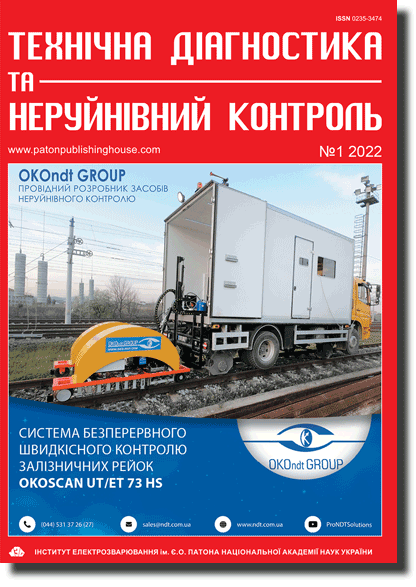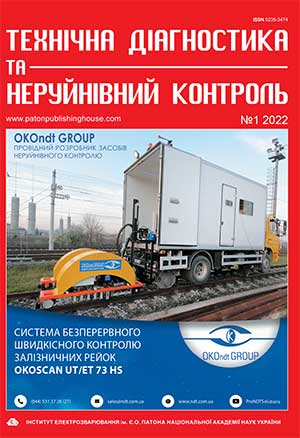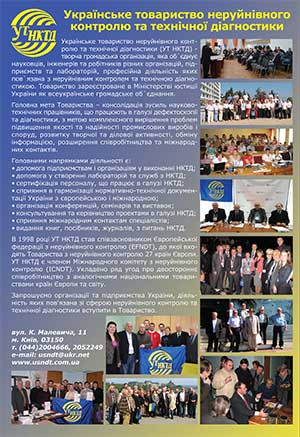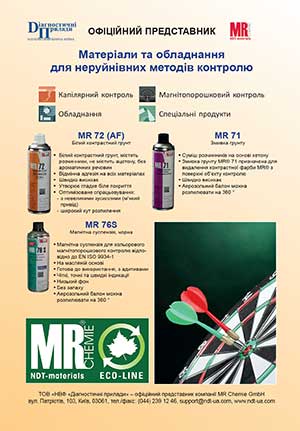| 2022 №01 (05) |
DOI of Article 10.37434/tdnk2022.01.01 |
2022 №01 (02) |
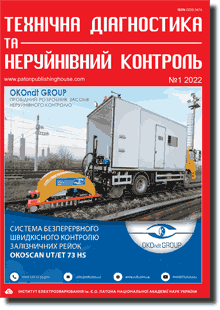
"Tekhnichna Diahnostyka ta Neruinivnyi Kontrol" (Technical Diagnostics and Non-Destructive Testing) #1, 2022, pp. 11-21
Optimization of the design of eddy current probe of parametric type to detect surface cracks
V.M. Uchanin
G.V. Karpenko Physico-Mechanical Institute of NASU. 5 Naukova str., 79060, Lviv, Ukraine. E-mail: vuchanin@gmail.com
The paper summarizes the results of research concerned with the optimization of the eddy current probe of the parametric type used for surface defects detection. It is shown that the choice of eddy current probe diameter signifi cantly depends on the smallest length of cracks needed to be detected. In particular, it was determined that to detect a crack longer than 2 mm, it is optimal to use an eddy current probe with windings mounted on the 1.2 mm diameter ferrite core. To detect shorter cracks longer than 1 mm, it is necessary to use an eddy current probe with windings on the 0.75 mm diameter ferrite core. The influence of ferrite core parameters (length, magnetic permeability, and off set of winding from the ferrite core end) on the effi ciency of parametric type eddy current probes is analyzed. The results obtained should be used for eddy current probe optimization. The conditions of separation of defect and liftoff influence are analyzed by interpretation of signals in the complex plane, and the possibility of their separation for the developed eddy current probes for all nonmagnetic structural alloys is shown. The design of a parametric type eddy current probe makes it possible to increase their quality factor more than twice. The optimal choice of the cable for connection of an eddy current probe and flaw detector is considered. The optimized parametric eddy current probes were tested. The high sensitivity of the developed probe to short cracks longer than 2 mm with reliable separation of the defect and lift-off influence was shown. Ref. 21, Tabl. 2, Fig. 12.
Keywords: eddy current non-destructive testing, surface crack, eddy current probe, ferrite core
Received: 18.03.2022
References
1. Dorofeev, A.L., Kazamanov, Yu.G. (1980) Electromagnetic flaw detection. Moscow, Mashinostroenie [in Russian].2. Gerasimov, V.G., Pokrovsky, A.D., Sukhorukov, V.V. (1992) Non-destructive testing. In: 5 books. Book 3: Electromagnetic testing. Moscow, Vysshaya Shkola [in Russian].
3. Libby, H.L. (1971) Introduction to Electromagnetic Non-destructive Test Methods. New-York, etc: Wiley-Interscience.
4. García-Martín, J., Gómez-Gil, J., Vázquez-Sánchez, E. (2011) Non-destructive techniques based on eddy current testing. Sensors, 11, 2525-2565. https://doi.org/10.3390/s110302525
5. AbdAlla, A.N., Faraj, M.A., Samsuri, F. et al. (2019) Challenges in improving the performance of eddy current testing: Review. Meas. Control, 52, 46-64. https://doi.org/10.1177/0020294018801382
6. Rao, B.P.C. (2011) Eddy Current Testing: Basics. J. of Non-Destructive Testing & Evaluation, 10(3), 7-16.
7. Hagemaier, D.J. (1991) Application of crack detection to aircraft structures. In «Fatigue crack measurement: techniques and applications» (Eds K.J. Marsh, R.A. Smith and R.O. Ritchie). Warley (UK): EMAS, 419-455.
8. Uchanin, V. (2021) Enhanced eddy current techniques for detection of surface-breaking cracks in aircraft structures. Transactions on Aerospace recearch, 1(262), 1-14. https://doi.org/10.2478/tar-2021-0001
9. Uchanin, V. (2007) Specific features of the space distribution of the signal of an eddy-current converter caused by cracks of different lengths. Materials Science, 43(4), 591-595. https://doi.org/10.1007/s11003-007-0068-2
10. Sobolev, V.S. Shkarlet, Yu.M. (1967) Put-on and screen sensors. Novosibirsk, Nauka [in Russian].
11. Dyakin, V.V., Sandovsky, V.A. (1981) Theory and calculation of overhead eddy current converters. Moscow, Nauka [in Russian].
12. Sabbagh, H.A., Sabbagh, L.D., Bowler, J.R. (1988) A Model of Ferrite-core Probes over Composite Workpieces, Review of Progress in Quantitative Nondestructive Evaluation, 7A. New York, Plenum Press, 479-486.
13. Sabbagh, L.D., Hedengren, K.H., Hurley, D.C. (1991) Interaction of Flaw with a Ferrite-core Eddy Current Probe: Comparison Between Model and Experiment, Review of Progress in Quantitative Nondestructive Evaluation, Vol. 10A. New York, Plenum Press, 883-888.
14. Beda, P.I. (1970) Examination of signal of overhead sensor depending on change of sizes and location of crack type defects. Defektoskopiya, 1, 62-68 [in Russian].
15. (2000) EN 13860-2 Non-destructive testing - Eddy current examination - Equipment characteristics and verifi cation - Part 2: Probe characteristics and verifi cation, European Committee for standardization.
16. Capobianco, T.E., Splett, J.D., Iyer, H.K. (1990) Eddy Current Probe Sensitivity as a Function of Coil Construction Parameters. Research in Nondestructive Evaluation, 2, 169-186. https://doi.org/10.1080/09349849009409496
17. Capobianco, Т.Е. (1987) Field mapping and performance characterization of commercial eddy current probes. Review of Progress in Quantitative Nondestructive Evaluation, Vol. 6 A, New York, Plenum Press, 687-694. https://doi.org/10.1007/978-1-4613-1893-4_77
18. Uchanin, V. (2012) Invariant effi ciency parameter of eddy-current probes for nondestructive testing. Materials Science, 48(3), 408-413. https://doi.org/10.1007/s11003-012-9520-z
19. Dunbar, W.S. (1985) The volume integral method of eddy current modeling, J. Nondestruct. Eval., 5(1), 9-14. https://doi.org/10.1007/BF00568758
20. (1996) User`s Guide for VIC-3D: An Eddy current NDE Code. Version 2.4. USA, Bloomington, Sabbagh Associates, Inc.
21. Uchanin, V., Nardoni, G. (2020) Eddy Current Detection of Cracks in Ferromagnetic Steel Structures, in «The Fundamentals of Structural Integrity and Failure». Ed. Richard M. Wilcox, Nova Science Publishers, NY, USA, 193-221.
Advertising in this issue:
The cost of subscription/purchase order journals or individual articles
| Journal/Currency | Annual Set | 1 issue printed |
1 issue |
one article |
| TPWJ/USD | 384 $ | 32 $ | 26 $ | 13 $ |
| TPWJ/EUR | 348 € | 29 € | 24 € | 12 € |
| TPWJ/UAH | 7200 UAH | 600 UAH | 600 UAH | 280 UAH |
| AS/UAH | 1800 UAH | 300 UAH | 300 UAH | 150 UAH |
| AS/USD | 192 $ | 32 $ | 26 $ | 13 $ |
| AS/EUR | 180 € | 30 € | 25 € | 12 € |
| SEM/UAH | 1200 UAH | 300 UAH | 300 UAH | 150 UAH |
| SEM/USD | 128 $ | 32 $ | 26 $ | 13 $ |
| SEM/EUR | 120 € | 30 € | 25 € | 12 € |
| TDNK/UAH | 1200 UAH | 300 UAH | 300 UAH | 150 UAH |
| TDNK/USD | 128 $ | 32 $ | 26 $ | 13 $ |
| TDNK/EUR | 120 € | 30 € | 25 € | 15 € |
AS = «Automatic Welding» - 6 issues per year;
TPWJ = «PATON WELDING JOURNAL» - 12 issues per year;
SEM = «Electrometallurgy Today» - 4 issues per year;
TDNK = «Technical Diagnostics and Non-Destructive Testing» - 4 issues per year.





